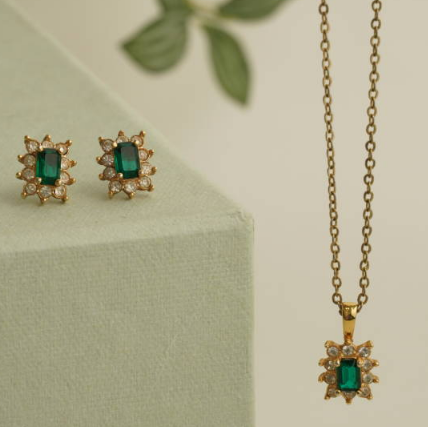It’s not all gold that glitters – well, not exactly gold. For example, gold-plated jewelry consists of a thin layer of gold wrapped around a base metal such as brass or copper. When the coating of gold-plated jewelry begins to fade, gold-plated jewelry may lose its luster, exposing the metal underneath. This discoloration can be frustrating, but it’s not inevitable. Below, we’ve summarized four simple tips and tricks from professionals. Follow this solid gold advice from jewelry designers and experts to prevent discoloration for longer.
What Is Gold-Plated Jewelry?
As mentioned above, gold-plated jewelry refers to jewelry that contains a base metal (such as copper or brass) and a thin layer of gold. Through the electroplating process, the metal is encased in gold.

Not all gold-plated jewelry is created equal. There are several plating methods, and coatings can range from the equivalent of the first coat of paint to extremely thick, so it’s less likely to tarnish or fade over time. The more microns of gold used (i.e., millionths of a meter), the better, as gold-plated jewelry is less likely to change color.
Why Does Gold-Plated Jewelry Change Color?
Before we discuss the tips to prevent discoloration, let’s first address the reasons why it happens. The tarnishing is largely due to the fact that the gold plating is a thin layer above the base metal, which makes the part stronger and less prone to bending. Unfortunately, over time, base metals can eventually surface and cause discoloration of the metal and gold. This process breaks down the gold and requires proper polishing and maintenance to restore its luster. Fortunately, there are a few tricks you can use to prevent gold-plated jewelry from changing color, thus maintaining its luxurious appearance.
Clean Your Jewelry Regularly
Marisa Hordern, founder of the jewelry brand Missoma, says that jewelry can be cleaned with “a soft, abrasive, lint-free cloth or suede to maintain its shine”. The brand recommends cleaning at least once a year, and every three to six months for favourite pieces.
Start by gently wiping the surface of your gold-plated jewelry, then clean or topical as needed. Amber Glassman, CEO and co-founder of Bryan Anthonys, agrees with this lint-free cloth tip: “Don’t use a polishing cloth because it will peel off the plating,” she says. ”
“Cleaning and wiping down your jewelry regularly after wearing it can help your jewelry stay shiny and scratch-free for longer,” adds Sally Rong, founder of Rellery. However, in the case of gold-plated sterling silver, Misho founder and creative director Suhani Parekh suggests that regular wear can actually be part of the care process. “The oils in our skin help prevent tarnishing on silver,” she shared.
If you need a deep cleanse, Sophie Monet Okulick, founder of the eponymous label Sophie Monet, recommends “mixing warm water and dish soap in a small bowl, soaking the pieces for a few minutes, then rinsing and wiping them clean.” “It is important not to use antibacterial soaps, as this chemical may tarnish the gold plating. If that still doesn’t work, you can always send the parts in for professional cleaning or replating.

Avoid Contact with Water
To prevent your jewelry from premature damage, be sure to remove your gold-plated jewelry when showering or swimming. “Chlorine, salt water, and fresh water can damage precious metals by darkening or corroding them,” Hodden told Birdy. “Soapy water in baths and showers can also leave a film that makes the metal look dull.” With chemicals in perfumes, hairsprays, makeup, deodorants, and other beauty products, Missoma’s golden rule is to make gold-plated jewelry the last thing you put on, the first thing you take off.
Use Caution When Using Perfumes
Going encourages gold-plated jewelry owners to avoid spraying gold-plated jewelry, even solid gold jewelry, directly with perfume. “Depending on the fragrance, the chemical creates a reaction similar to oxidation,” says the Fortune & Frame designer, “which basically means it can turn your gold color into black.” It’s reversible, but it can be a bit shocking if you didn’t expect it.”
Strategically Store Gold-Plated Jewelry
Knowing how to best store your usual necklace or earrings is just as important as knowing how to clean your gold-plated jewelry. All of our experts recommend storing jewelry in bags, boxes, or jewelry boxes to prevent discoloration and fading. If you want to take care of your jewelry thoroughly, store it in a dark, cool, dry place to avoid humidity and heat, which can cause tarnishing.
In addition, Acosta said that storing jewelry in bags or in a dark area can prevent exposure to daily humidity, which may also alter the initial plating. Make sure your parts are separated to some extent to avoid contact with objects that could scratch or shatter the finish, Glassman says.
Case in point: When gold-plated jewelry is exposed to external elements or chemicals, certain base metals may cause discoloration. Brass, for example, is a very reactive metal, and when it is exposed to high humidity or salt water, brass begins to react and break through the plating.